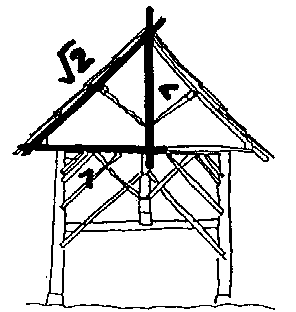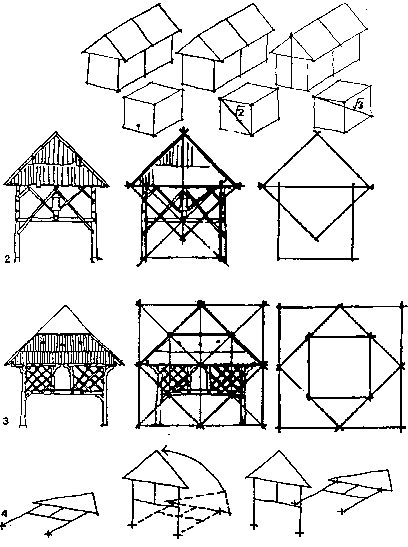

The robust type is based on a square: the diagonal from the central point on one side of the square to the central point on the adjacent one is 1/sqrt2 (sqrt2 = square root of 2). The key points form a net which can be defined as:
1/1, 1/sqrt2, 1/2, 1/(2*sqrt2), ...
 In the case of the slender type, typical of
Gorenjska
and Stajerska, only three lengths are used: 1, sqrt2, sqrt3.
The square root of three can be reduced to close approximation:
In the case of the slender type, typical of
Gorenjska
and Stajerska, only three lengths are used: 1, sqrt2, sqrt3.
The square root of three can be reduced to close approximation:
sqrt3 = 1 + (sqrt2/2)
The three lengths represent the basic elements of a cube: the side and the diagonal of the square, and the diagonal of the cube.
The order existent in the form of the hayrack enables construction without the knowledge of sophisticated building techniques because the dimensions of the front, unfolded on the terrain (carpenter's practice), represent the starting point for further building. The insertion of the nucleus - to strengthen the structure - is a routine matter.
Circumferential analysis shows that, regardless of the construction, the golden section, has been observed by the builders. The existing hayracks are living proof of the above statements. They show that the way to arrive at the golden section has been simplified with the help of the diagonal of a square, used by ancient masters, who had no kind of sophisticated mathematical knowledge or technical drawings for reference.

The hayrack has been built according to the proportions most widely used in architecture, those aesthetically pleasing proportions which are closest to man's concept of beauty, and are in harmony with the surroundings - that is, in golden section. Lacking sophisticated knowledge of mathematical rules was not an obstacle: with the help of one isosceles triangle, the building of a hayrack was simplified to the maximum: New technology has introduced combine harvesters and silos. Both have deprived the hayrack of grain and fodder.
Actually, the silo is not a qualitative replacement for the hayrack. Single stretched hayracks still function, but other types have become too expensive to maintain.
Long ago, man erected the first kozolec; the centuries trimmed it:
functionally, constructionally, artistically. Is the economic policy
of that same man going to change the course of its evolution?
Has the Slovenian hayrack reached the point of extinction?